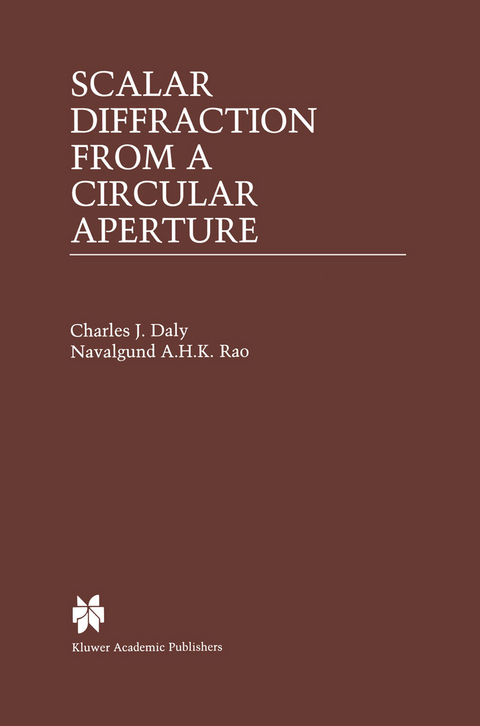
Scalar Diffraction from a Circular Aperture
Springer (Verlag)
978-0-7923-7810-5 (ISBN)
Included are novel insights on mirror-image diffraction, autoconvolution diffraction, and coherent and incoherent averaging. Examples from ultrasonic imaging, a coherent imaging modality, are used to develop a fairly general theory that connects over a century of research on scalar diffraction from a circular aperture. The material is based on a synthesis of mathematics, physical optics, linear systems theory, and scalar diffraction theory. Thus, engineers, scientists, mathematicians, and students working in optics, acoustics, antenna design, biomedical engineering, non-destructive testing, and astronomy will find Scalar Diffraction from a Circular Aperture interesting, provocative, and useful.
1. Introduction.- 1. Ultrasonic Reflection Imaging.- 2. Diffraction from a Circular Aperture.- 3. The Arccos & Lommel Diffraction Formulations.- 4. One-way and Two-way Diffraction.- 5. Spatial Averaging.- 6. The Need for Diffraction Correction.- 7. Mathematical Definitions.- 8. Scope and Assumptions.- 9. Preview.- 10. Criticism and Counter.- 2. Literature Review.- 1. Ultrasonic Reflection Imaging.- 2. Diffraction from a Circular Aperture.- 3. Spatially Averaged Diffraction Corrections.- 4. Short-Time Fourier Techniques.- 5. Short-Time Fourier Techniques in Ultrasound.- 6. Chapter Summary.- 3. Two Diffraction Formulations.- 1. The Lommel Diffraction Formulation.- 2. Discussion of the Lommel Diffraction Formulation.- 3. The Arccos Diffraction Formulation.- 4. Discussion of the Arccos Diffraction Formulation.- 5. Similarities and Differences.- 6. An Approximate Fourier Transform Pair.- 7. Verification.- 8. Computational Considerations.- 9. The Focused Case.- 10. Chapter Summary.- 4. Spatially Averaged one-way Diffraction.- 1. Spatially Averaged Arccos Diffraction Formulation.- 2. Analysis of Time-Domain Results.- 3. Spatially Averaged Lommel Diffraction Formulation.- 4. Analysis of Frequency-Domain Results.- 5. Extending Fourier Equivalence.- 6. Verification.- 7. Computational Considerations.- 8. Chapter Summary.- 5. Spatially Averaged two-way Diffraction.- 1. Spatially Averaged Arccos Diffraction Formulation.- 2. Spatially Averaged Lommel Diffraction Formulation.- 3. Analysis of Frequency-Domain Results.- 4. Extending Fourier Equivalence.- 5. Verification.- 6. Computational Considerations.- 7. Chapter Summary.- 6. Experimental Investigation.- 1. A Computational Consideration.- 2. Equipment and Processing.- 3. Experiments, Images, and Centroids.- 4. Discussion of Results.-5. Chapter Summary.- 7. Analytical Investigation.- 1. Diffraction and Linear Models.- 2. Harmonic Imaging and Non-Linear Ultrasound.- 3. Focused One-Way Results.- 4. Coherent vs. Incoherent Averaging.- 5. Mirror-Image vs. Autoconvolution Diffraction.- 6. Chapter Summary.- 8. Recommendations for Further Research.- 1. General.- 2. Fourier Equivalence.- 3. Spatially Averaged One-Way Diffraction.- 4. Spatially Averaged Autoconvolution Diffraction.- 5. More Experiments and Analysis.
| Reihe/Serie | The Springer International Series in Engineering and Computer Science ; 549 |
|---|---|
| Zusatzinfo | XV, 175 p. |
| Verlagsort | Dordrecht |
| Sprache | englisch |
| Maße | 155 x 235 mm |
| Themenwelt | Informatik ► Grafik / Design ► Digitale Bildverarbeitung |
| Informatik ► Theorie / Studium ► Künstliche Intelligenz / Robotik | |
| ISBN-10 | 0-7923-7810-5 / 0792378105 |
| ISBN-13 | 978-0-7923-7810-5 / 9780792378105 |
| Zustand | Neuware |
| Informationen gemäß Produktsicherheitsverordnung (GPSR) | |
| Haben Sie eine Frage zum Produkt? |
aus dem Bereich


